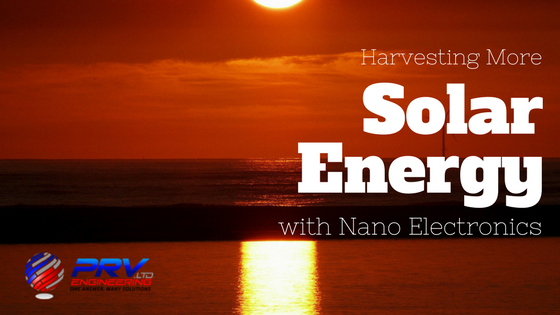
There are a number energy sources available in nature but solar energy is by far the most abundant. Our sun provides more solar energy in one hour than the entire world consumes in a year. The question is how do we collect and store this abundance of energy more effectively?
How Nano Electronics Improve Solar Energy
Most conventional solar panels made from crystalline silicon can only utilise 15-25% of sunlight they absorb. Alternatively, thin-film technologies include semiconductor material composed of copper, indium, gallium, and selenium or amorphous silicon.
Nano electronics is a promising advancement for cheaper and more efficient clean, renewable energy. It has the potential for new manufacturing processes and devices to make solar cells thinner and more effective. To give an idea of the scale – a nanometer is one-billionth of a meter where 100 000 nanometers is as thick as a sheet of paper.
Using Nano materials to produce solar cells can effectively increase efficiency and energy storage. Here, silicon and other materials used to manufacture solar cells function at a much higher level. It could improve energy collection enabling energy systems to capture more light to convert into electrical power. Nanotechnology could impact all aspects of the value-added chain in the energy sector.
Applications of Nano Electronics in Solar Energy
Over the years there have been impressive developments in solar power. Advancement in technology and increased manufacturing resulted in cost reduction, increased reliability and efficiency of photovoltaic installations. Rising electricity costs and environmental concerns make solar energy even more important.
Prototype solar panels using nanotechnology are more efficient in converting sunlight into electricity than standard panels. They are cheaper to manufacture and install since they can use a print-like manufacturing process and made in flexible rolls instead of solid panels.
- New types of batteries already use nanotechnology making it less flammable, faster-charging, lightweight, more efficient with a longer electrical charge.
- Mobile electronic devices use thin-film solar electric panels for power and fitted onto computer cases. Flexible nanowires woven into clothing generate usable energy on-the-move. This is achieved from light, friction or body heat.
- Research of nanoscience-based options are underway to convert excess heat in computers, automobiles, homes and power plants into usable electrical power.
- Wires containing carbon nanotubes in the electric grid has much lower resistance than the high-tension wires currently used in the electric grid thus reducing transmission power loss.
- Researchers are investigating carbon nanotube “scrubbers” and membranes to separate carbon dioxide from power plant exhaust.
- Oil and gas extraction uses nanotechnology through the use of gas lift valves in offshore operations. Nanoparticles can also detect microscopic oil pipeline fractures.
New Solar Cells vs Old Technology
Current nanotechnology solar cells are not as efficient as traditional ones but their lower cost makes up for it. In the long term nanotechnology using quantum dots should be far more cost effective and efficient than conventional cells. New solar cells will consist of two energy-capturing layers. Silicon cells make up the first layer and copper oxide the second layer. This is supposed to capture light waves from the blue spectrum of sunlight yielding a higher output.
The sun is a mostly untapped resource with unlimited solar energy with the potential to power everyone on earth. Renewable energy has enormous potential and should be utilised more.
What are your thoughts on global warming and how solar energy can help short and long term? Share your thoughts in the comments section below or find us on Twitter, Facebook, You Tube, Google+ or LinkedIn.
This site uses Akismet to reduce spam. Learn how your comment data is processed.


 Mail:
Mail: 




Leave a Comments